Framing statement
It is ten minutes past ten, on the eve of Thursday 7th May 2015. Darkness falls across Lincolnshire, and the first batch of ballot papers from the general election arrive at the Drill Hall, and the count begins…
“Spoiled” began as a simple installation idea, predominantly inspired by the theatre company Stan’s Cafe, which turned into something with greater substance with the addition of video and spoken word. I performed this piece in the Green Room of the Lincoln Drill Hall on Wednesday 4th May 2016. My aim was to make the invisible use of the room visible, showing and telling the audience about the ballot count and the process behind it, while still showcasing its regularly visible use alongside it. I performed this piece as a one-to-one performance, with each audience member remaining in the room with me for approximately ten minutes at a time, mostly listening or watching and occasionally participating.
The general format ran as follows: I would collect an audience member from the foyer of the Drill Hall and lead them to the performance space, where I would instruct them to wait outside and follow the instructions on the door sign, which requested that they remove their shoes and then knock to alert me that they were ready. When they did so, I would invite them in and ask them to take a seat. A video of my walk from EMMTEC, the university polling station, to the Drill Hall, would be playing, and I would lock the door behind us and watch the video with them while standing by the door. When the video looped, I began to speak to the audience member about various things relating to the voting process or to the layout of the room, including references to the ballot count, the suffragette movement, the typhoid epidemic, and more. I also asked the audience to participate; firstly in gluing a paper skirt to one doll, and secondly in drawing or writing on another doll and posting it into my ballot box. After I finished speaking to them, I would walk to the door and unlock it, before letting them out and leading them back to the foyer.
As mentioned, my biggest inspiration was the theatre company Stan’s Cafe, specifically their piece Of All the People in All the World, but I have also been inspired by Lone Twin and their Speeches project. Both of these works played a key factor not only in my development but also in my final piece.
Analysis of process
My process began on the very first visit to our site, The Drill Hall. When I heard about the fact that the Green Room was used to lock up the ballots from elections after the ballot count took place in the main hall, I was intrigued to find out more, and I knew I wanted to explore that and create a performance around it. My first step was to find out more about the process of the count, so I contacted the Lincolnshire County Council and spoke to the elections staff there. It was from them that I found out about how the count works, and I was able to make use of that information for the development of my piece. Also during my process, I began to conduct research into various companies who produce site specific performances. My search led me to a company by the name of Stan’s Cafe, who have been creating site specific shows since 1991. The piece of theirs that interested me the most was Of All the People in All the World, a piece which uses installation techniques to create a spectacle that makes people think about their place in the world. Stan’s Cafe wanted their piece to look at “creating an ever changing landscape of rice” (Stan’s Cafe, 2016). This inspired me to use some of their techniques in order to make my own piece which created some kind of continuously developing view of the Green Room, specifically about the voting system with emphasis on the ballot count.
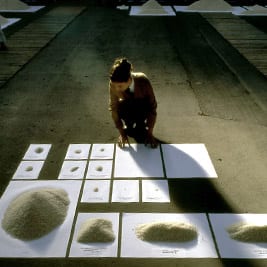
My initial idea was that I wanted to make paper dolls, and they would have a ballot cross on their chest. I hoped to make enough paper dolls for every person of voting age in Lincoln to put out on the floor of the Green Room, sorted by age and potentially other factors, but after my interview in person with a representative from the Lincolnshire City Council, I found out that I would be unable to obtain that information because of confidentiality. I then adapted my idea and instead planned simply to cover the floor of the Green Room with the paper dolls. I started preparing the dolls early so I could try them out on the floor and see how they were going to look, and eventually decided that I wanted my audience member to sit down, and that I was going to leave a small path between the dolls that led from the door to the chair. Upon receiving feedback from Conan about my first ideas for my performance content, which had primarily been political, he suggested that I strip it back to simply talk about the process of voting, and keeping my personal political leanings out of the piece. After that, I realised that it would be vastly more interesting to discuss the processes behind an election, because the media already puts so much focus on the politics of it. Therefore, I geared the performance towards a breakdown of various processes that go into an election, e.g. the ballot count, how a winner is calculated in an election, etc. Conan also mentioned that the dolls laying out on the floor with the cross on their chests looked almost like corpses, and I used that as a jumping-off point to reference the typhoid epidemic in my piece, which held a special significance as a group from last year had performed a piece about typhoid in the Green Room.
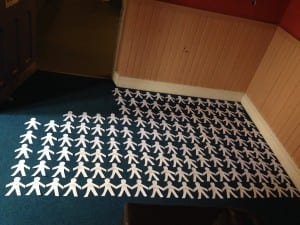
My aim was to shed light on the hidden parts of not only the election process, but the Drill Hall also, since not a lot of people know that it is the building used for the ballot count. As my process continued, I found myself considering whether I wanted to remove the furniture from the Green Room or not. I researched into Willi Dorner’s Bodies in Urban Spaces, examining how the project brought negative space to life and showcased things that people inherently know are there, but do not acknowledge. With this in mind, I decided that I wanted to use the room to make a point about how the storage of the ballots within the Green Room does not stop it from also being the dressing room for the theatre. I wanted to emphasise the idea of the Drill Hall’s dual existence. With this in mind I decided that my only modifications to the room’s layout would be to push all furniture to the sides, with the exception of my props and set for my performance. I knew I wanted the audience member to sit, and originally I had considered walking around them as I spoke. However after a preview of the spoken material, performed in this way, Michael suggested to me that it might be more intimate and capture the audience member’s attention more if I simply sat in front of them and had a conversation face-to-face. This reminded me of Lone Twin’s Speeches project, a series of performances in which the performer stands still on a soapbox and talks to their audience. However, since I had been advised to keep the piece apolitical, I then made the decision to provide a chair for myself and a table between myself and the audience member.
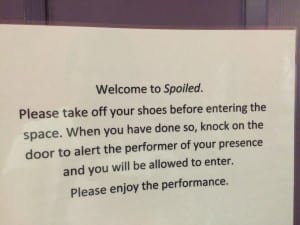
From the beginning I had wanted some kind of audience participation to be involved in my piece, and I had developed it multiple times over the course of my preparation; I considered some kind of exchange: a normal ballot paper swapped for a doll, or vice versa, or potentially having the audience member cut dolls out with me. I decided then that I would add the table in order to facilitate a couple of parts of the performance that required something to lean on; firstly, gluing paper skirts onto some of the dolls, and secondly when the audience member and I cast our votes and put them into the ballot box. I chose to add the section with the skirts because I had scripted myself a small segment mentioning women getting the vote, and after Michael’s feedback, during which he suggested I do something with the dolls that represented that moment in the piece, I thought of paper skirts. I asked the rhetorical question of whether it mattered what a person had between their legs when they were voting, and so the way I wanted to represent it was the traditional method of distinguishing a paper doll’s sex: adding a skirt. The second part of the audience participation was the vote. Lone Twin said of their Speeches project that “in inviting attention we’re also inviting people to go the other way and express disinterest, bemusement and perhaps anger” (Whelan, cited in Lavery and Williams, 2011), which interested me and made me eager to keep the audience participation in the piece to see what sort of reactions I would get from the audience members. Therefore, the chance for an audience member to draw on the doll was born from the thought that an audience member could do almost anything they wanted to do when they were presented with one of the dolls and a pen. I gave them that choice, just as one is given a choice of what to vote for within a real election, and then each paper doll was added to the box regardless of what was written on them. intend to use that in my post-performance, which I will discuss later. I also chose to ask the audience member to remove their shoes, so that in case they walked over the dolls, they would not rip. Another decision I made was that during each performance, the door to the room would be locked. This was to create the atmosphere of being in the room with the ballot papers on election night after they had been counted.
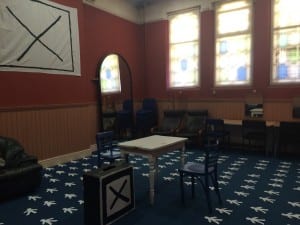
During my performance, I wanted to speak about the journey a ballot paper makes on election night. Therefore, as part of this process I wanted to take that journey myself and be able to showcase it to the audience in some way. My first idea was to take a walk from all the polling stations in Lincoln and play all the videos simultaneously, however, I was unable to get the full list of all the locations from the City Council. Therefore, because I am a student, I chose just to walk from the university polling station situated in the EMMTEC building on campus to the Drill Hall, recording a time lapse video of my journey. I then edited the video to be black and white for better contrast, and decided I would have it projected onto the wall throughout my performances (video can be seen below). Unfortunately I found an obstacle when I realised that the wall was orange and the video would not show very clearly. I then decided to make a background for it myself; I took a fitted bed sheet and cut it into a rectangle, before adding the ballot cross to it with paint. I also added the ballot cross motif to the box itself, before painting the rest of it black to look like an authentic ballot box. Continuing this reoccurring theme, I also dressed myself in a white shirt painted with a ballot cross on the chest. I wanted to look as much like the paper dolls as possible, in an attempt to bring light to the fact that all we really are during an election is a cross in a box.
As mentioned briefly earlier, I have decided to add a post-performance element to this piece. After I found out that the City Council keeps ballot papers for one year in case of a recount before they destroy them, I wanted to incorporate that somehow. My eventual decision was to also keep my paper dolls for a year and then return to the Drill Hall on the day of next year’s site specific performances and burn them outside in the courtyard. I also intend to read each one before I burn it, and document them with photographs as I do so.
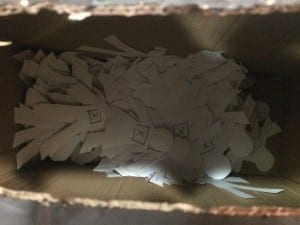
Performance evaluation
My piece began at 12pm on Wednesday 4th May 2016, and ran multiple times over the course of 5 hours. I had a total of 16 available time slots and 15 of them were filled. Most audience members seemed keen to engage with my participatory activities, and left the room with pensive looks about them as if contemplating the information I had presented to them. Many thanked me for their new knowledge about the Drill Hall. I feel the most effective part of this performance was the use of chairs so I could sit opposite the person and keep their attention, but then direct it elsewhere when I wanted to do so. However, there were times that being so intimately tucked away with one person opposite me felt overwhelming, and I occasionally struggled to keep eye contact and found it hard to refrain from tripping over my words.
If I were ever to take this work further and try to improve it I would like to work on holding eye contact with the audience member, and generally being more confident in the delivery of my piece. Another thing I would like to do if I were performing it again would be potentially to only run the video once at the beginning of each performance, as I felt that there were times when the audience member’s eyes would wander back to the video even though I did not reference it. Another interesting idea might be to take the performance to other places around the country where the ballot count happens and perform it there to new audiences, much like Stan’s Cafe does with Of All the People in All the World.
Mike Pearson quotes Patrice Pavis in saying that “(site specific) refers to a staging and performance conceived on the basis of a place in the real world” (Pavis, cited in Pearson, 2010). Like many before me, I’m sure, I first took this simply to mean staging some kind of a play outdoors. However, this module has broadened my understandings of what a performance can be. I realise now that performance cannot be simply defined as one thing or another. It is a great many things, and site-specific performance is just one of those.
Bibliography
Lavery, C. and Williams, D. (2011) Practising Participation: A Conversation with Lone Twin. Performance Research, 16 (4) 7-14.
Pearson, M. (2010). Site Specific Performance. Houndmills, Basingstoke, Hampshire: Palgrave Macmillan.
Stan’s Cafe (2016) Of All the People In All the World [online]. Available from http://www.stanscafe.co.uk/project-of-all-the-people.html#introduction [Accessed 8th May 2016].
Dorner, W. et al (2014) Bodies in Urban Spaces – Photobook [online]. Available from http://www.ciewdorner.at/index.php?page=work&wid=74 [Accessed 8th May 2016].